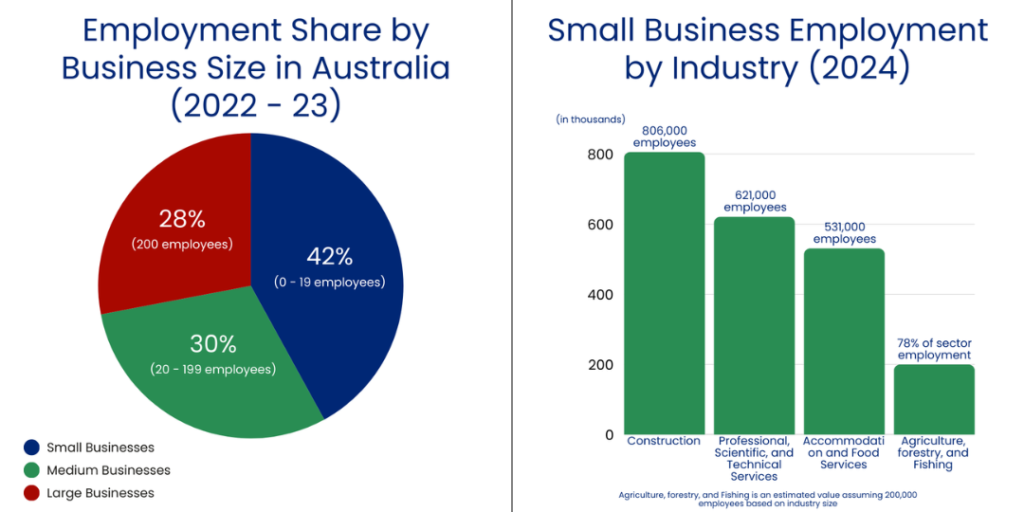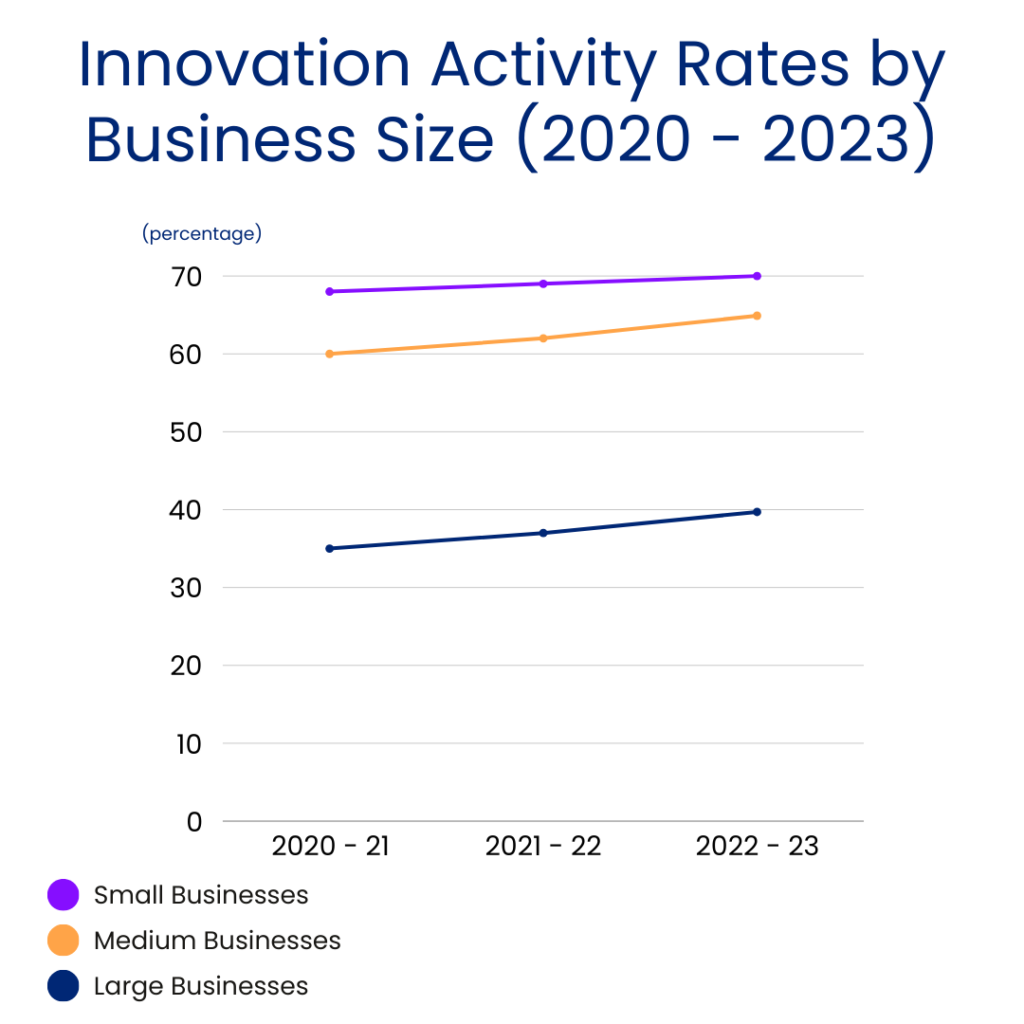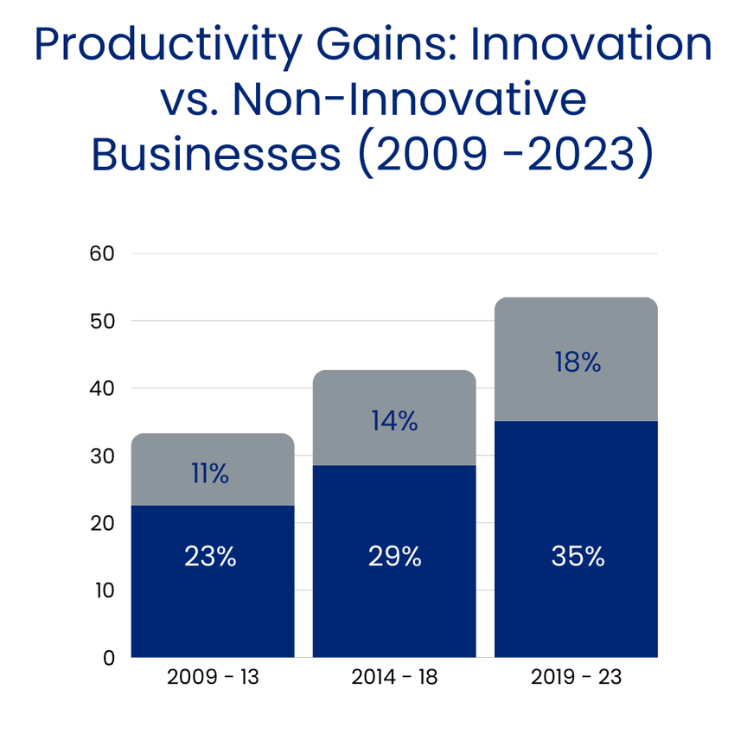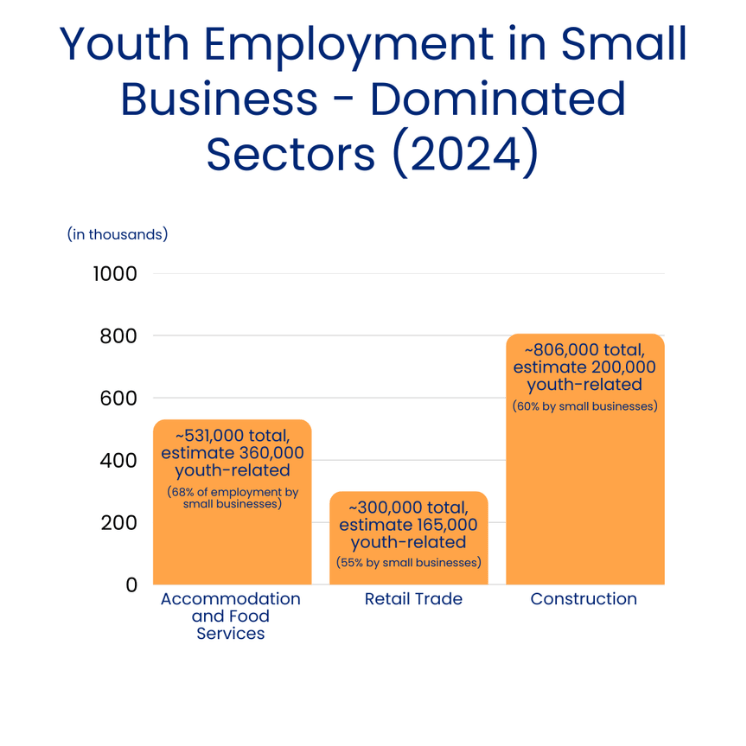Small businesses are the lifeblood of the Australian economy, serving as a cornerstone for economic growth, employment, innovation, and the enhancement of living standards. Defined by the Australian Bureau of Statistics (ABS) as entities with fewer than 20 employees, small businesses constitute over 97% of all businesses in Australia, making them a dominant force in shaping the nation’s economic landscape. Their contributions extend beyond mere numbers; they foster resilience, adaptability, and diversity, ensuring that economic activity thrives even in challenging times. This report examines their pivotal role, substantiated by government-backed data and real-world examples, focusing on their employment contributions as a percentage of the workforce, their capacity for innovation, their impact on living standards, and their unique ability to provide better employment opportunities for young people compared to large corporations.
Small Businesses as Economic Drivers
Small businesses are indispensable to Australia’s economic vitality, contributing significantly to gross domestic product (GDP), employment, and regional development. The Australian Small Business and Family Enterprise Ombudsman (ASBFEO) estimates that small businesses account for approximately 33% of Australia’s GDP, a figure that reflects their substantial role in generating economic output across a wide array of sectors, including retail, construction, agriculture, and professional services. This contribution is particularly notable given their size, as they often operate with limited resources yet manage to punch above their weight in economic terms.
As of June 2024, the ABS Counts of Australian Businesses recorded 2.59 million active small businesses, representing 97.2% of all businesses in the country. This vast network spans urban centers and rural regions alike, providing a decentralized economic foundation that reduces dependence on a handful of large corporations. In regional areas, such as Tasmania or Far North Queensland, small businesses often serve as the primary economic engines, supporting local supply chains and sustaining communities where large firms have little presence. For instance, in the agriculture sector, small family farms—many employing fewer than five people—produce goods like wool, beef, and dairy, contributing to Australia’s $70 billion agricultural output in 2022-23, as reported by the Department of Agriculture, Fisheries and Forestry.
Their agility is a key strength. Unlike large corporations burdened by complex hierarchies, small businesses can pivot quickly to meet market demands or capitalize on emerging opportunities. During the COVID-19 pandemic, for example, many small retailers shifted to online platforms within weeks, a flexibility that preserved jobs and revenue streams. The Treasury’s 2021 Intergenerational Report highlights this adaptability as a buffer against economic shocks, noting that small businesses help diversify risk and stabilize the economy during downturns.
Policy implications further underscore their importance. Government initiatives, such as the Small Business Digital Adaptation Program (launched in 2020), have provided grants to help small firms adopt technology, enhancing their competitiveness. This support reflects a recognition that small businesses are not just supplementary but foundational to economic prosperity, driving growth through grassroots efforts that ripple across the nation.

Employment Contribution: Percentage of the Workforce
Small businesses are Australia’s largest private-sector employers, offering jobs to millions and absorbing a significant share of the workforce. According to the ASBFEO’s 2022-23 Small Business Counts report, small businesses employed over 5 million people across selected industries (excluding financial and insurance services), equating to 42% of the private sector workforce in those sectors. This percentage positions them as a critical employment engine, outpacing medium and large businesses in job creation within these areas.
The ABS Australian Industry report (May 2024) provides a detailed breakdown of this impact. Small businesses dominate employment in key industries: construction (806,000 employees), professional, scientific, and technical services (621,000), and accommodation and food services (531,000). In agriculture, forestry, and fishing, they account for 78% of employment, a testament to their role in sustaining rural economies. By contrast, large businesses (those with 200 or more employees) employ fewer people in these labour-intensive sectors, often focusing on capital-intensive operations like mining or manufacturing, where automation reduces workforce needs.
This employment footprint is diverse. Of the 2.59 million small businesses, 62.5% are non-employing sole traders, while 26% employ 1-4 people, and 8.7% employ 5-19 people (ABS, August 2024). This structure allows small businesses to create a broad spectrum of jobs, from part-time roles for students to skilled positions for professionals. In retail, for example, small independent stores employ local staff, often providing flexible hours that suit workers with caregiving responsibilities or those studying—a flexibility less common in corporate settings.
Case studies illustrate this impact. In South Australia, small wineries in the Barossa Valley employ hundreds seasonally, supporting tourism and local economies. Similarly, in urban areas, small cafes and trades businesses hire apprentices and casual workers, filling gaps that large firms overlook. During the post-COVID recovery, small businesses added 300,000 jobs between 2020 and 2022, per ABS Labour Force data, demonstrating their responsiveness to labour market needs.
Policy support enhances this role. The JobMaker Hiring Credit scheme (2020-22) incentivized small businesses to hire young workers, reinforcing their status as a workforce backbone. Compared to large corporations, which may offshore jobs or prioritize experienced hires, small businesses provide a decentralized, accessible employment network that sustains livelihoods nationwide.

Fostering Innovation
Innovation drives economic progress, and small businesses in Australia are at the forefront of this endeavour, despite their resource constraints. The ABS Innovation in Australian Business 2022-23 report reveals that 45% of all businesses were innovation-active in the two years ending June 2023, with small businesses (0-19 employees) contributing significantly at a 39.7% innovation rate. While this is lower than medium firms (64.9%), their sheer volume—over 2.5 million entities—means they account for a substantial share of new ideas, from products to operational processes.
The nature of their innovation is diverse. IP Australia’s 2023 Australian IP Report notes that small businesses with intellectual property rights (patents, trademarks, designs) contribute 35% to GDP and 51% to exports. These firms often focus on niche markets, developing tailored solutions that larger corporations, with their broader focus, may not prioritize. For instance, in the ICT sector, small startups lead in adopting emerging technologies: 17% use data analytics, and 10.7% leverage the Internet of Things, per ABS data, outpacing larger firms slowed by legacy systems.
Real-world examples highlight this ingenuity. Naked Wines, a small Australian business, disrupted the wine industry by using a crowdfunding model to connect independent winemakers with consumers, bypassing traditional distributors. This innovation not only boosted sales but also supported small producers. Similarly, regional microbreweries like Stone & Wood in New South Wales have pioneered craft beer trends, driving tourism and exports while employing local talent. In technology, Canva—a startup turned global success—began as a small business in Sydney, revolutionizing graphic design with its accessible platform, now valued at billions and contributing to Australia’s tech reputation.
Government support amplifies this innovation. Programs like the Entrepreneurs’ Programme and R&D Tax Incentive provide small firms with funding and expertise, encouraging experimentation. The Productivity Commission’s 2023 report on innovation ecosystems notes that small businesses often act as “testbeds” for new ideas, diffusing technology across industries. Their ability to innovate without the red tape of large corporations positions them as agile contributors to economic dynamism, a role that policy must continue to nurture.


Enhancing Living Standards
Small businesses elevate living standards by creating income opportunities, supporting community development, and driving productivity gains that benefit society. The Treasury’s 2003-04 Budget Paper No. 1 emphasizes that productivity and workforce participation—both bolstered by small businesses—are essential for sustaining Australia’s living standards, particularly as the population ages. Employing 42% of the private workforce, small businesses distribute income more equitably than large firms, where earnings often concentrate among executives and shareholders.
This income distribution has tangible effects. The Productivity Commission’s research links economic growth—fuelled by small business activity—to reduced poverty and improved health outcomes, such as higher life expectancy. In suburban and rural areas, small retailers, cafes, and service providers offer affordable goods and services, directly enhancing quality of life. For example, in Victoria, Aboriginal small businesses have thrived under government procurement policies, with spending rising 29.3% to $21.6 million in 2021-22 (Victorian Government First Peoples Relations report). Firms like Kinaway Chamber of Commerce members employ locals and reinvest profits into community programs, lifting living standards through economic inclusion.
Innovation by small businesses further boosts living standards. The ABS reports that innovation-active businesses achieve productivity gains of 22.6%-35.1% (2009-23), compared to 10.7%-18.4% for non-innovative peers. These gains translate into higher wages, better products, and lower costs for consumers. In Tasmania, small agribusinesses like Tasmanian Lavender Gifts produce artisanal goods, employing locals and attracting tourists, with 39% of businesses innovation-active (ABS 2022-23). This activity strengthens regional economies and enhances community well-being.
Policy plays a role here too. The National Reconstruction Fund (2023) targets small businesses in priority sectors like renewables and manufacturing, aiming to boost productivity and living standards. By supporting small firms, governments ensure that economic benefits reach grassroots levels, countering the wealth concentration often seen with large corporations.


Employment Opportunities for Young People
Small businesses offer young people employment opportunities that often surpass those provided by large corporations, emphasizing flexibility, hands-on experience, and pathways to entrepreneurship. The Department of Industry, Science and Resources (2020) notes that small firms employ 44% of the total workforce, with a propensity to hire less-experienced workers, giving youth a critical entry point into the labour market.
The ABS Survey of Education and Work (May 2020) found that 88% of 15-24-year-olds were engaged in education or employment, with small businesses playing a key role during the COVID-19 recovery. In sectors like accommodation and food services, where small firms account for 68% of employment, young people secure casual and part-time roles, gaining skills and income. Unlike large corporations, which often demand formal qualifications or years of experience, small businesses value adaptability and willingness to learn, making them ideal for youth.
The Productivity Commission’s 2024 report on youth labour markets highlights this advantage. Post-pandemic, small businesses drove employment growth, hiring less-experienced workers as the labour force expanded by 4.2% between 2020 and 2023. Boost Juice, which began as a small business and now operates a franchise network, employs thousands of young Australians annually, offering training and career progression absent in many corporate roles. In contrast, large firms like banks or mining companies often prioritize established professionals, limiting opportunities for youth without tertiary degrees.
Case studies reinforce this trend. In Queensland, small construction firms hire apprentices at higher rates than large builders, providing hands-on training that leads to trade qualifications. The Kinaway Business Awards in Victoria celebrate Aboriginal small businesses that mentor young Indigenous workers, fostering skills and self-determination. Government policies, like the Youth Jobs PaTH program, further support this by connecting young people with small business employers, recognizing their role in workforce development.
Statistics and Examples of Positive Impacts
- Employment Statistics: Small businesses employed 5.1 million people in 2022-23 (ASBFEO), with 62.5% non-employing sole traders, 26% employing 1-4 people, and 8.7% employing 5-19 (ABS, August 2024). This diversity ensures widespread job creation.
- Innovation Example: Canva’s journey from a small Sydney startup to a global design leader showcases how small businesses innovate, contributing to tech exports and inspiring entrepreneurship.
- Living Standards Impact: Tasmanian Lavender Gifts and similar small firms drive rural economies, with 39% innovation-active, boosting tourism and community resilience (ABS 2022-23).
- Youth Opportunity: Boost Juice’s franchise model and Aboriginal small businesses under Kinaway employ and train youth, offering pathways large firms often lack.
Conclusion
Small businesses in Australia are vital to economic growth, employing 42% of the private workforce, fostering innovation, enhancing living standards, and providing young people with accessible, meaningful employment opportunities. Government-backed reports from the ABS, ASBFEO, Treasury, and Productivity Commission affirm their impact, revealing a sector that adapts to challenges like pandemics and demographic shifts. Through statistics and examples—Canva’s innovation, Boost Juice’s youth employment, and regional firms’ community contributions—small businesses demonstrate their capacity to drive Australia’s economy forward, ensuring prosperity and opportunity for all. Policymakers must continue supporting this sector through targeted initiatives, recognizing its indispensable role in shaping a vibrant, inclusive future.
Broker.com.au helps entrepreneurs and business owners secure the best financing options for growth and stability. Contact us at 1300 373 300 or [email protected] to get started.
Explore more financial insights on our Resources & Learning page.



